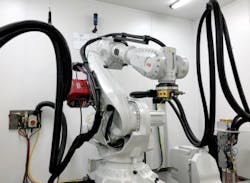Research contract could make complex metal additive manufacturing a reality
Lockheed Martin (Bethesda, MD) and the Office of Naval Research (Arlington, VA) are exploring how to apply artificial intelligence (machine learning) to train robots to independently oversee and optimize additive manufacturing (3D printing) of complex parts. The two-year, $5.8 million contract will specifically study and will customize multiaxis robots that use laser beams to deposit material, with the goal of developing software models and sensor modifications for the robots to build better components.
"We will research ways machines can observe, learn, and make decisions by themselves to make better parts that are more consistent, which is crucial as 3D-printed parts become more and more common," says Brian Griffith, Lockheed Martin's project manager. "Machines should monitor and make adjustments on their own during printing to ensure that they create the right material properties during production."
This multiaxis printer uses laser beams to deposit material and make metal components, which could be important resources for people far from supply chains. (Courtesy: Lockheed Martin)
Lockheed Martin's research will help machines make decisions about how to optimize structures based on previously verified analysis. The company, along with its team, will vet common types of microstructures used in an additive build. Although invisible from the outside, a part could have slightly different microstructures on the inside. The team will measure the performance attributes of the machine parameters, these microstructures, and align them to material properties before integrating this knowledge into a working system. With this complete set of information, machines will be able to make decisions about how to print a part that ensures good performance.
The team is starting with the most common titanium alloy, Ti-6AI-4V, and integrating the related research with seven industry, national lab, and university partners.
For more information, please visit www.lockheedmartin.com.
Industrial Laser Solutions Editors
We edited the content of this article, which was contributed by outside sources, to fit our style and substance requirements. (Editor’s Note: Industrial Laser Solutions has folded as a brand and is now part of Laser Focus World, effective in 2022.)
